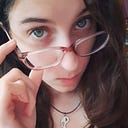Creating Dust Particles in Unity 3D
After exploring the process to structure my Office Den level and its lighting, it’s time to look at one of the little details that helped breathe life into this scene. It might seem like a simplistic addition, but ambient particles add a sense of space and realism to the scene.
Objective: Learn how to add a particle system and style it to act and look like dust particles.
Table of Contents:
· Adding a Particle System
∘ Randomizing Direction and Position
∘ Changing particles from squares to circles
· The Result
Adding a Particle System
- Let’s start by adding a particle system: Right-click in your Inspector → Effects → Particle System.
You should now have what seems to be a bunch of flowing squares in your scene.
2. Now, we need to adjust some of the parameters in the Inspector so that we can get them to behave and look properly.
Note: The numbers used in the parameters may vary depending on your scene. You will mostly want to keep your numbers at the most minuscule values you can afford, but only if it works for the size and spacing of your scene.
- Start Speed: Dust particles float around lazily — they’re not very fast or erratic, so we’ll keep our starting speed at a measly 0.03. Feel free to play around with this value to test what seems more natural to your scene.
- Start Size: The size of a dust particle is an itty bitty wisp we don’t usually get to see dust particles unless they’re exposed to some form of light because of how tiny they are. Thus, the starting size is at 0.05
Randomizing Direction and Position
3. Next, we move on to the Shape segment where we will select Sphere.
It might seem a bit confusing at first, but the Shape does not refer to the individual shape of the particles meaning it won’t turn the squares into spheres. Instead, this will change how the particles float around in your scene. This is essentially like putting the particles inside an empty sphere. They will float around only within the sphere defined on your scene sort of like a bounding box.
It’s best to have a visual reference:
Here you can see the cone shape, if you select this option, the particles will be constricted to only move within this cone structure.
Whereas selecting a sphere shape spreads them out more organically.
4. Adjusting the Sphere parameters will ensure that you have the most organic spread for the particles to float around in.
- Radius: Determines the size of our invisible Sphere. This should be set to best fit your needs so numbers will vary.
- Randomize Direction: This will make it so the direction in which the particles float is randomized instead of a constant pattern.
- Randomize Position: Ensure that the individual particles spawn from random positions.
Note: Randomize Direction and Position both follow the same number criteria in the sense that the higher the number the more randomization we get. The direction is kept at a minium since, as previously mentioned, dust particles have a more ebb and flow to them. The position can be left to discretion.
Changing particles from squares to circles
5. Go to the Renderer tab, there you can find the default material of the particle system.
You don’t need to create a brand new material for this, Unity is equipped with a Default-Particle material that you can assign to turn the squares into spheres.
With that, your dust particles should be all set!
The Result
In the gif image below, I point out some of the visible dust particles in the Game window.
You can see further results in the scene window whilst the particle system is selected in the Hierarchy. This makes them easier to spot since the Editor outlines them.
